IRISH HISTORY SINCE 1850
2. An Gorta Mór
3. The Land League
4. Parnell and Home Rule
5. Unionism
6. The Cultural Revival
7. Home Rule
8. The Easter Rebellion
9. The War of Independence
10. The Free State: '20s
11. The Free State: '30s
12. The Troubles: '60s & '70s
13. The Troubles: '80s & '90s
14. The Celtic Tiger
15. Death of the Tiger
16. Sources
An Gorta Mór - The Great Hunger
This rickety system held together only because the rural peasants had a cheap and plentiful source of food. The potato, introduced to Ireland about 1590, could grow in the poorest conditions, with very little labor. This was important because laborers had to give most of their time to the farmers they worked for, and had very little time for their own crops.
The actual cause of (potato crop) failure was phytophthora infestans potato blight. The spores of the blight were carried by wind, rain and insects and came to Ireland from Britain and the European continent. A fungus affected the potato plants, producing black spots and a white mold on the leaves,soon rotting the potato into a pulp.
By the summer of 1847, over three million people were being fed by government soup kitchens and those organized by Quakers. So many people died in so short of time that mass graves were provided.
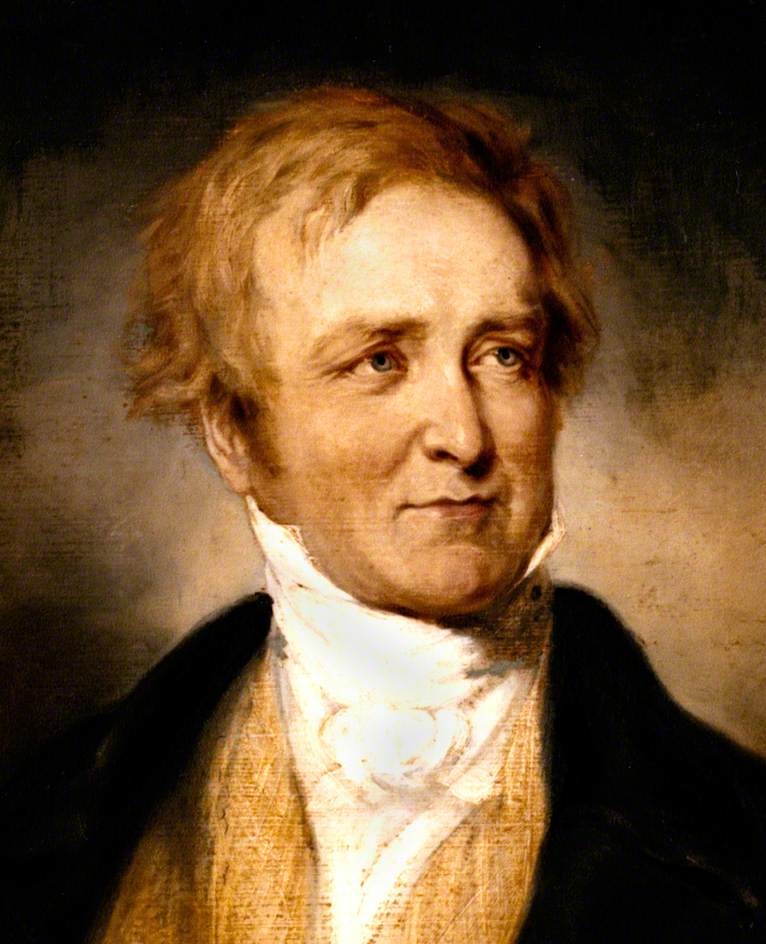
The dominant economic theory in mid-nineteenth century Britain was laissez-faire, which held that it was not a government's job to provide aid for its citizens, or to interfere with the free market of goods or trade. Despite this philosophy, the initial response to the Famine under the British Prime Minister Sir Robert Peel, was prompt, efficient and interventionist. He sent over a Scientific Commission to examine the facts. The commissioners reported that 1/2 of the crop was now destroyed, or unfit for use, but they incorrectly diagnosed the cause of the blight.
Food prices in Ireland were beginning to rise, and potato prices had doubled by December, 1845. Meanwhile, the Irish grain crop was being exported to Britain. Public meetings were held, and prominent citizens called for the exports to be stopped and for grain to be imported as well. However, this would have meant repealing the Corn Laws, and there was great opposition in Britain to this.
The Corn Laws, an exception to the doctrine of laissez-faire, laid down that large taxes had to be paid on any foreign crops brought into Britain. This kept grain prices artificially high, and the British traders would lose profits if the laws were repealed. Since the Act of Union made Ireland legally a part of the United Kingdom, its corn crop could be moved to England without incurring the tax. However, corn crops brought into Ireland to relieve the famine could be taxed.
Prime Minister Peel pushed through a repeal of the Corn Laws in 1846. This split the Tory Party and Peel was forced to resign. In a powerful speech to Parliament he said, "Good God, are you to sit in cabinet and consider and calculate how much diarrhea, and bloody flux, and dysentery a people can bear before it becomes necessary for you to provide them with food?"
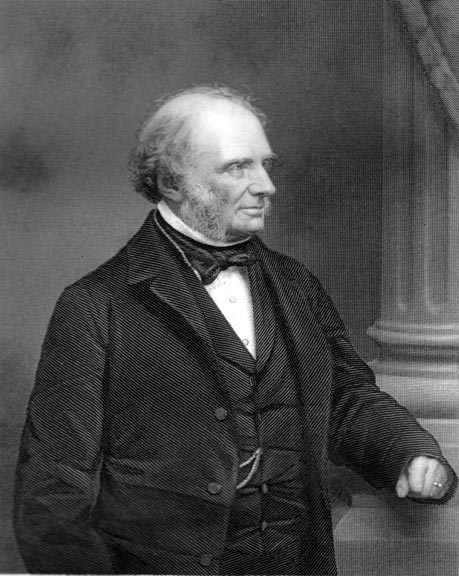
Peel was succeeded at Prime Minister by Lord John Russell, a rigid exponent of laissez-faire. In October, 1846, as it became clear that over 90% of the potato crop of Ireland was blighted, Lord Russell set out his approach to the famine: "It must be thoroughly understood that we cannot feed the people. . . . We can at best keep down prices where there is no regular market and prevent established dealers from raising prices much beyond the fair price with ordinary profits."
Russell's policies emphasized employment rather than food for famine victims, in the belief that private enterprise, not government, should be responsible for food provision. He also stressed that the cost of Irish relief work should be paid for by Irishmen. Peel's Relief Commission was abolished and relief work was put in the hands of 12,000 civil servants in the Board of Works who only found work for 750,000 of the starving people. In return for hard (and often pointless) work, starving peasants were paid starvation wages.
Tens of thousands of people died during the winter of 1846, but Russell and his colleagues never thought of interfering with the structure of the Irish economy in the ways that would have been necessary to prevent the worst effects of the famine.
The Society of Friends, or Quakers, first became involved with the Irish Famine in November 1846, when some Dublin-based members formed a Central Relief Committee.They intended that their assistance supplement other relief. However, the relief provided by the Quakers proved crucial in keeping people alive when other relief systems failed. A number of Quakers were critical of government relief policies, holding them to be inadequate and misjudged.
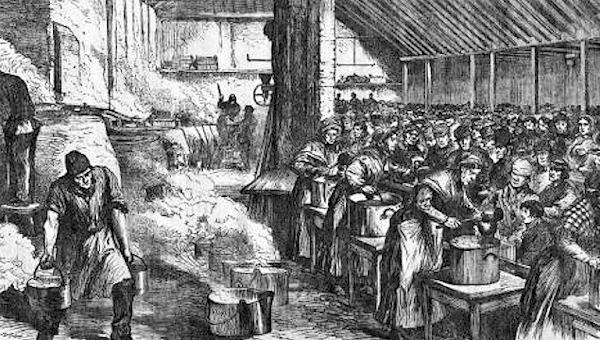
The Quakers donated food,mostly American flour, rice, biscuits, and Indian meal,along with clothes and bedding. They set up soup kitchens, purchased seed, and provided funds for local employment. During 1846-1847, the Quakers gave approximately £200,000 for relief in Ireland.
There were soup kitchens established in 1847 by the government, local authorities, charities,and private individuals. But many of them were established by Protestant charities, and would only offer food to Catholics (the overwhelming majority of the starving) if they converted. There's also the London chef, Alexis Soyer, who set up soup kitchens in Dublin, achieved great economies of scale, and charged Dublin's elite five shillings to watch. Nevertheless, soup kitchens probably supplied food for 3,000,000 people. The government also set up public-work schemes, which paid minimally, but enough to buy food. In 1847, 715,000 men were employed in this way. There were also workhouses, which provided food and shelter. In 1849, 1,000,000 people were subject to them.
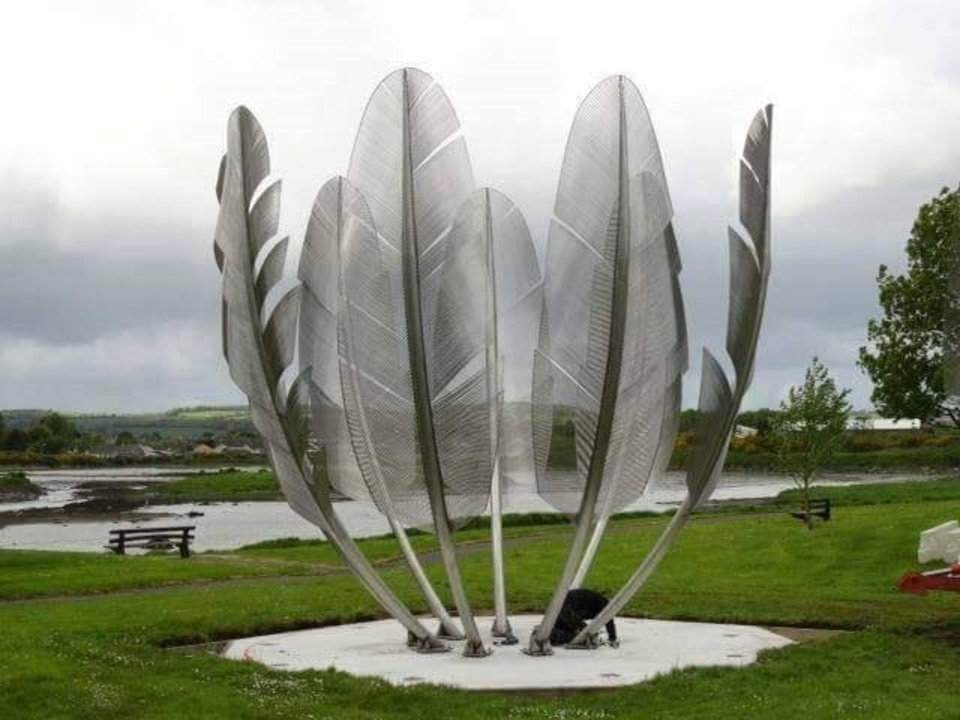
of a donation from the Choctaw Nation to the people of Ireland in 1847
Donations for the Irish Famine came from distant and unexpected sources. Calcutta, India sent £16,500 in 1847, Bombay another 3,000. Florence, Italy, Antigua, France, Jamaica, and Barbados sent contributions. The Choctaw tribe in North America, recently forcibly removed from their homeland through the Trail of Tears and ravaged by disease on their reservation in Oklahoma, sent $710. Many major cities in America set up Relief Committees for Ireland, and Jewish synagogues in America and Britain contributed generously.
Many Irish still believe that Queen Victoria donated merely 5 pounds to famine relief, but in 1847 she donated £2000, with a further £500 given to a ladies' Clothing Fund.
Desperately poor Irish emigrants, struggling to survive in the slums of New York, contrived to send home more than $326,000 [about £9 million today] in just two months.
The British Relief Association was founded in 1847, and raised money in England, America and Australia. They benefited from a "Queen's Letter" from Victoria, appealing for money to relieve the distress in Ireland. The total raised was£171,533. A second "Queen's Letter" in October of 1847 reflected a hardening of British public opinion, as it raised hardly any additional funds. In total, the British Relief Association raised approximately £470,000.
In August, 1847, when the Association had a balance of £200,000, their agent in Ireland, Polish Count Strzelecki, proposed that the money be spent to help schoolchildren in the west of Ireland. The British Treasury Secretary, Charles Edward Trevelyan, warned against it, fearing "it might produce the impression that the lavish charitable system of last season was intended to be renewed." Strzelecki proved adamant and Trevelyan conceded that a small portion of the funds could be used for that purpose.
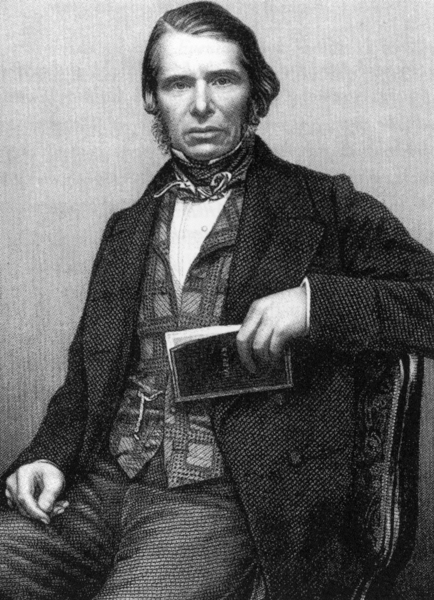
To this day, Trevelyan continues to divide opinion. The Cork Multitext Project notes:
Trevelyan's most enduring mark on history may be the quasi-genocidal anti-Irish racial sentiment he expressed during his term in the critical position of administrating relief for the millions of Irish peasants suffering under the Irish famine as Assistant Secretary to HM Treasury (1840–1859) under the Whig administration of Lord Russell.
On the other side, the BBC's Historic Figures webpage states:
His most lasting contribution, however, began in the 1850s with the publication of his and Sir Stafford Northcote's report on "The Organisation of the Permanent Civil Service." The report led to the transformation of the civil service. Educational standards and competitive admission examinations ensured that a more qualified body of civil servants would become administrators.
During the height of the famine it is suggested that Trevelyan deliberately dragged his feet in disbursing direct government food and monetary aid to the Irish due to his strident belief in laissez-faire economics and the free hand of the market. In a letter to an Irish peer, Lord Monteagle of Brandon, a former Chancellor of the Exchequer, he described the famine as an "effective mechanism for reducing surplus population" as well as "the judgement of God" and wrote that "The real evil with which we have to contend is not the physical evil of the Famine, but the moral evil of the selfish, perverse and turbulent character of the people."
Trevelyan never expressed remorse for his comments, even after the full dreadful scope (approximately 1 million lives) of the Irish famine became known. His defenders claim that other factors than Trevelyan's personal acts and beliefs were more central to the problem.
Cecil Woodham-Smith, considered the preeminent authority on the Irish Famine, wrote of him in The Great Hunger: Ireland 1845-1849:
his mind was powerful, his character admirably scrupulous and upright, his devotion to duty praiseworthy, but he had a remarkable insensitiveness. Since he took action only after conscientiously satisfying himself what he proposed to do was ethical and justified he went forward impervious to other considerations, sustained but also blinded by his conviction of doing right.
In 1845, a famine year in Ireland, 3,251,907 quarters (8 bushels = 1 quarter) of corn were exported from Ireland to Britain. That same year, 257,257 sheep were exported to Britain. In 1846, another famine year, 480,827 swine and 186,483 oxen were exported to Britain.
Cecil Woodham-Smith wrote that, "...no issue has provoked so much anger or so embittered relations between the two countries (England and Ireland) as the indisputable fact that huge quantities of food were exported from Ireland to England throughout the period when the people of Ireland were dying of starvation."
Although the potato crop failed, the country was still producing and exporting more than enough grain crops to feed the population. But that was a "money crop"and not a "food crop," and could not be interfered with. In fact, Ireland was actually producing sufficient food, wool and flax, to feed and clothe not 9,000,000, but 18,000,000 people, yet a ship sailing into an Irish port during the famine years with a cargo of grain was sure to meet six ships sailing out with a similar cargo.
One of the most remarkable facts about the famine period is that there was an average monthly export of food from Ireland worth £100,000. For almost the whole of the famine, Ireland remained a net exporter of food. 9,992 calves were exported from Ireland to England during "Black '47," an increase of 33% from the previous year. In the 12 months following the second failure of the potato crop, 4,000 horses and ponies were exported. The export of livestock to Britain (with the exception of pigs) increased during the famine. The export of bacon and ham increased. In total, over 3,000,000 live animals were exported from Ireland between 1846-50, more than the number of people who emigrated during the famine years.
Almost 4,000 vessels carried food from Ireland to the ports of Bristol, Glasgow, Liverpool and London during 1847, when 400,000 Irish men, women and children died of starvation and related diseases. The food was shipped under guard from the most famine-stricken parts of Ireland: Ballina, Ballyshannon, Bantry, Dingle, Killala, Kilrush, Limerick, Sligo, Tralee, and Westport.
During the first nine months of "Black '47" the export of grain-derived alcohol from Ireland to England included the following: 874,170 gallons of porter, 278,658 gallons of Guinness, and 183,392 gallons of whiskey. The total amount of grain-derived alcohol exported from Ireland in just nine months of Black '47 was 1,336,220 gallons.
A wide variety of commodities left Ireland during 1847, including peas, beans, onions, rabbits, salmon, oysters, herring, lard, honey, tongues, animal skins, rags, shoes, soap, glue and seed.
The most shocking export figures concern butter. Butter was shipped in firkins, each one holding nine gallons. In the first nine months of 1847, 56,557 firkins were exported from Ireland to Bristol, and 34,852 firkins were shipped to Liverpool. That works out to be 822,681 gallons of butter exported to England from Ireland during nine months of the worst year of famine. If the other three months of exports were at all comparable, then we can safely assume that 1,000,000 gallons of butter left Ireland while 400,000 Irish people starved to death.
Obviously, there was sufficient food in Ireland to prevent mass starvation, and that food was brought through the worst famine-stricken areas on its way to England. British regiments guarded the ports and warehouses in Ireland to guarantee absentee landlords and commodity speculators their "free market" profits.
When Ireland experienced an earlier famine in 1782-83, ports were closed in order to keep home-grown food for domestic consumption. Food prices were immediately reduced within Ireland. The merchants lobbied against such efforts, but their protests were overridden. Everyone recognized that the interests of the merchants and the distressed people were irreconcilable. In the Great Famine, that recognition was disregarded.
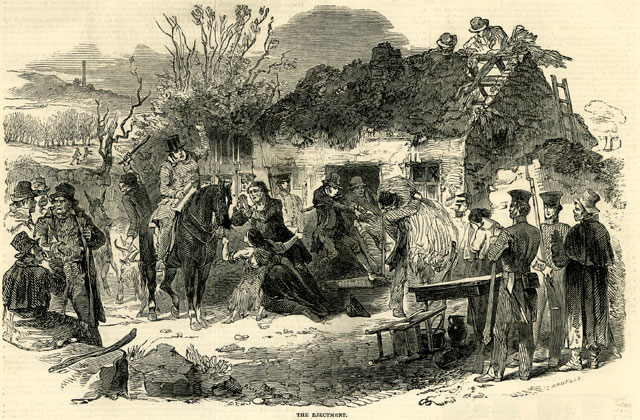
During the worst months of the famine, in the winter of 1846-47, tens of thousands of tenants fell in arrears of rent and were evicted from their homes. A nationwide system of ousting the peasantry began to set in, with absentee landlords,and some resident landlords as well, more determined than ever to rid Ireland of its "surplus" Irish. In 1850 alone, over 104,000 people were evicted.
With potato cultivation over because of the blight, tenants could pay no rents. Sheep and cattle could pay rent, so landlords decided to give the land over to them.
In 1841 the population of Ireland was given as 8,175,124. It is almost certain that, owing to geographical difficulties and the unwillingness of the people to be registered, the census of 1841 gave a total smaller than the population in fact was. Officers engaged in relief work put the population as much as 25% higher (over 10,000,000 people); landlords distributing relief were horrified when providing, as they imagined, food for 60 persons, to find more than 400. By 1851, after the famine, the population had dropped to 6,552,385. The census commissioners calculated that, at the normal rate of increase, the total should have been 9,018,799, so the loss of at least 2,500,000 persons had taken place.
Charles Edward Trevelyan, the British Treasury Secretary in charge, was the civil servant most involved in Irish famine relief. He firmly believed in a laissez-faire system. Trevelyan opposed expenditure and raising taxes, advocating self-sufficiency. He was convinced that any attempt to raise the standard of living of the poorest section of the population above subsistence level would only result in increased population, which would make matters worse.
In October, 1846, Trevelyan wrote that the overpopulation of Ireland "being altogether beyond the power of man, the cure has been applied by the direct stroke of an all-wise Providence in a manner as unexpected and as unthought of as it is likely to be effectual." Two years later, after over 1,000,000 people had died, he wrote, "The matter is awfully serious, but we are in the hands of Providence, without a possibility of averting the catastrophe if it is to happen. We can only wait the result." Later that year Trevelyan declared: "The great evil with which we have to contend is not the physical evil of the famine, but the moral evil of the selfish, perverse and turbulent character of the people." In 1848 Trevelyan was knighted for his services in Ireland.
The lead story in the August 30, 1847 edition of The Times said, "In no other country have men talked treason until they are hoarse, and then gone about begging for sympathy from their oppressors. In no other country have the people been so liberally and unthriftily helped by the nation they denounced and defied."
In another edition: "They are going. They are going with a vengeance. Soon a Celt will be as rare in Ireland as a Red Indian on the streets of Manhattan . . .Law has ridden through, it has been taught with bayonets, and interpreted with ruin. Townships leveled to the ground, straggling columns of exiles, workhouses multiplied, and still crowded, express the determination of the Legislature to rescue Ireland from its slovenly old barbarism, and to plant there the institutions of this more civilized land."
In 1848 Sir Charles Wood,the English Chancellor of the Exchequer, wrote to an Irish landlord: "I am not at all appalled by your tenantry going. That seems to be a necessary part of the process . . . We must not complain of what we really want to obtain."
In 1849 Edward Twisleton, the Irish Poor Law Commissioner, resigned to protest lack of aid from Britain. The Earl of Clarendon, acting as Lord Lieutenant of Ireland, told British Prime Minister Lord John Russel the same day, that "He (Twisleton) thinks that the destitution here [in Ireland] is so horrible, and the indifference of the House of Commons is so manifest, that he is an unfit agent for a policy that must be one of extermination."
James Wilson, the editor of The Economist, responded to Irish pleas for assistance during the famine by saying, "It is no man's business to provide for another." He thought it was wrong for officials to reallocate scarce resources, since, "If left to the natural law of distribution, those who deserve more would obtain it."
Most of the British legislators were influenced greatly by the work of Thomas Malthus, a political economist who died in 1834. In his most influential work, "Essay on the Principle of Population," he wrote:
If he cannot get sustenance from his parents, on whom he has a just demand, and if society does not want his labor, he has no claim of right to the smallest portion of food and, in fact, has no business to be where he is.
In December, 1848, Cholera began to spread through many of the overcrowded workhouses, pauper hospitals, and crammed jails in Ireland. On April 26, 1849, Lord Clarendon wrote to Prime Minister Russell: ". . . it is enough to drive one mad, day after day, to read the appeals that are made and meet them all with a negative . . . At Westport, and other places in Mayo, they have not a shilling to make preparations for the cholera, but no assistance can be given, and there is no credit for anything, as all our contractors are ruined. Surely this is a state of things to justify you asking the House of Commons for an advance, for I don't think there is another legislature in Europe that would disregard such suffering as now exists in the west of Ireland, or coldly persist in a policy of extermination." No advance was granted.
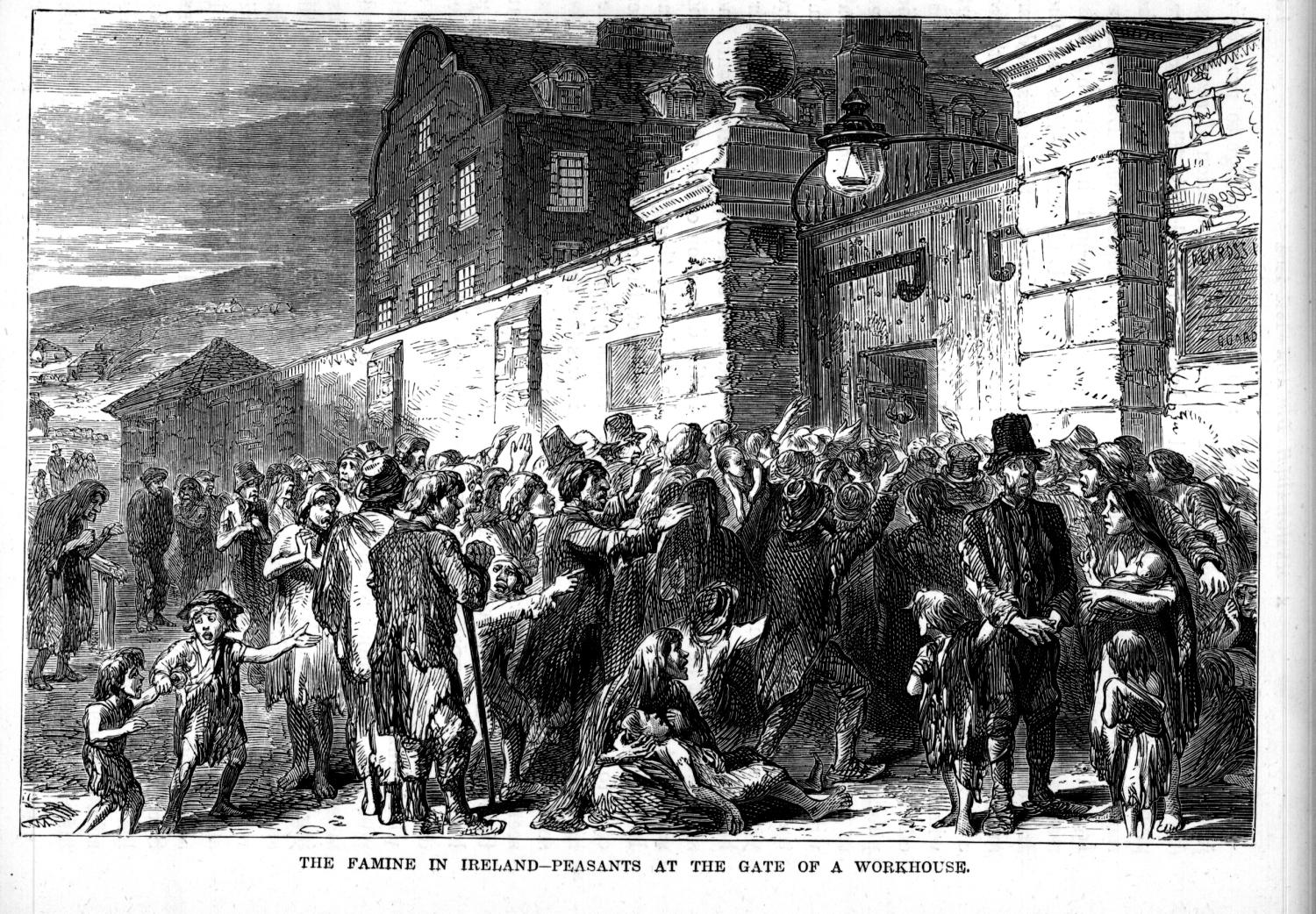
Initially, the greatest relief to the starving came through the Poor Law (1838), which aimed to provide accommodation for the absolutely destitute in workhouses. There were 130 of them in Ireland in 1845.
However, the conditions for entry were so strict that people would only go to them as a last resort. Families were torn apart, as women and men lived in different parts of the workhouse, and children were kept separately from adults. Inmates were forbidden to leave, and the food provided consisted of two meals a day, of oatmeal, potatoes, and buttermilk. There were strict rules against bad language, alcohol, laziness, malingering, and disobedience, and meals had to be eaten in silence. Able-bodied adults had to work at such jobs as knitting (for women) and breaking stones (for men).Children were given industrial training of some sort.
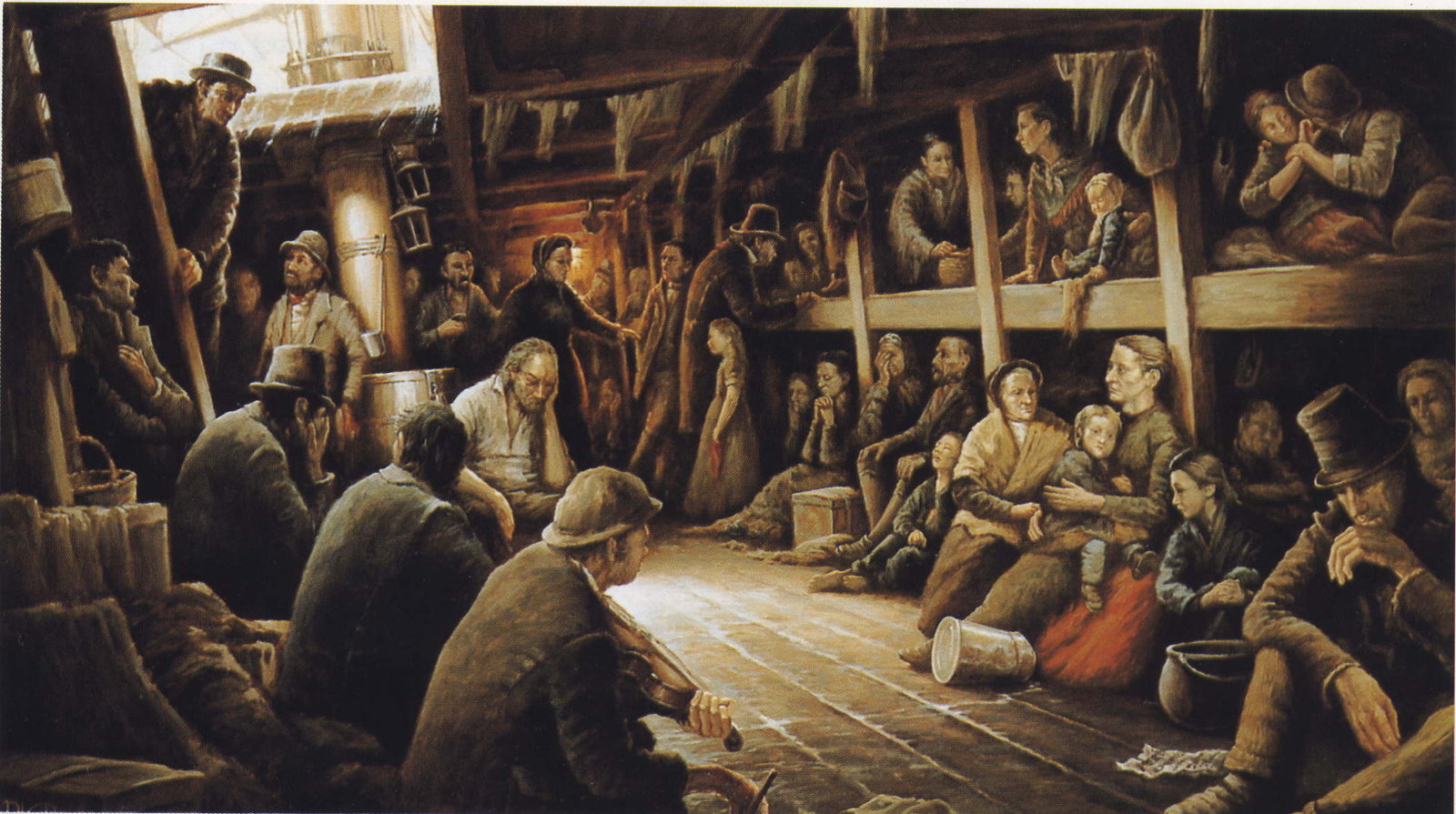
Between 1845 and 1855, nearly 2,000,000 people had emigrated from Ireland to America and Australia, and another 750,000 to Britain. The Poor Law Extension Act, which made landlords responsible for the maintenance of their own poor, induced some to clear their estates by paying for emigration of the poorer tenants. Although some landlords did so out of humanitarian motives, there were undoubtedly benefits to them, especially those who wanted to consolidate their land holdings or change from the cultivation of land to beef and dairy farming.
Emigration soared from 75,000 in 1845 to 250,000 in 1851. This chaotic, panic-stricken, and unregulated exodus was the largest single population movement of the 19th century. Thousands of emigrants died on board "coffin ships" during the Atlantic crossing. These were little more than rotting hulks, and their owners were plying a speculative trade. There were 17,465 documented deaths aboard these ships in 1847 alone. Thousands more died at disembarkation centers.